A 10-Year Statistical Analysis of Heavy Metals in River and Sediment in Hengyang Segment, Xiangjiang River Basin, China
Abstract
:1. Introduction
2. Materials and Methods
2.1. Description of the Research Area
2.2. Data Source
2.3. Data Preparation
2.4. Measuring Sample Distribution
2.5. Box-Cox Transformation
2.6. Inspecting Normality
- H0: the hypothetical distribution of the sample distribution is the same as a normal distribution.
- Ha: the hypothetical distribution is different from a normal distribution.
2.7. Platform, Package, and Mapping
3. Results
3.1. Sample Visualization and Measures
3.2. Transformation and Normality Test
3.3. Characterizing Temporal and Spatial Dependency
4. Discussion
4.1. The Sample Distributions of Heavy Metal Variables
4.2. The Temporal and Spatial Characteristics
- H0: there is no difference between the means of two consecutive years.
- Ha: the mean of the year is significantly larger than the mean of the next year.
4.3. The Unique Behavior of Cr
4.4. Implications for Further Data Analyses
5. Conclusions
- The heavy metal elements of As, Cd, and Pb in water column and Mn, Cu, Zn, As, Cd, Hg, and Pb in sediment that consisted of all available data covered in this study were generally positively skewed in distribution shape. However, the Cr in sediment presented roughly symmetrical sample distribution shape. The unique behavior of Cr in sediment was discussed, and a possible explanation was given that a relatively fast process of deposition-releasing equilibrium of Cr between water column and sediment was present.
- Box-Cox transformation has effectively improved the normality of all variables; however, data censoring and the discretization in samples have a negative effect on its outcome.
- The large sample size in the water monitoring data set avails a better discovery of the temporal and spatial characteristics in the data, such that the influence of policy interference and river branches were discovered. The sediment data set contained much less temporal and spatial information, but the dependence on space was more visible than the dependence on time for most of the studied elements (except in the case of Cr, which only showed clear relations with the time factor).
Acknowledgments
Author Contributions
Conflicts of Interest
Appendix A
| Element | Method | Reference/Standard | Lower Detection Limit (as in the Reports) |
|---|---|---|---|
| Cu(WAT) | Graphite furnace atomic absorption spectroscopy (GF-AAS) | Analyzing methods for water and waste water, 4th edition (in Chinese) | 0.01 mg/L |
| Zn(WAT) | Inductively coupled plasma atomic emission spectroscopyy (ICP-AES) | Chinese standard GB/T 5750.6-2006 | 0.01 mg/L |
| As(WAT)(2006−2010) | Silver diethyldlthiocarbamate spectrophotometric method | Chinese standard GB/T 7485-1987 | 0.007 mg/L |
| As(WAT)(2010−2015) | Atomic fluorescence spectroscopy (AFS) | Analyzing methods for water and waste water, 4th edition (in Chinese) | 0.00007 mg/L |
| Hg(WAT) | Atomic fluorescence spectroscopy (AFS) | Analyzing methods for water and waste water, 4th edition (in Chinese) | 0.00005 mg/L |
| Cd(WAT) | Graphite furnace atomic absorption spectroscopy (GF-AAS) | Analyzing methods for water and waste water, 4th edition (in Chinese) | 0.0001 mg/L |
| Cr(WAT) | Potassium permanaganate oxidation—diphenyl carbamide spectrophotometric method | Chinese standard GB/T 7466-1987 | 0.004 mg/L |
| Pb(WAT) | Graphite furnace atomic absorption spectroscopy (GF-AAS) | Analyzing methods for water and waste water, 4th edition (in Chinese) | 0.0001 mg/L |
| Mn(WAT) | Flame atomic absorption spectroscopy (FAS) | Chinese standard GB/T 11911-1989 | 0.01 mg/L |
| Cu(SED) | Flame atomic absorption spectroscopy (FAS) | Chinese standard GB 5085.3-2007 | 1 mg/kg |
| Zn(SED) | Flame atomic absorption spectroscopy (FAS) | Chinese standard GB/T 17138-1997 | 0.5 mg/kg |
| Mn(SED) | Atomic adsorption spectroscopy (ADS) | Contemporary analyzing methods of elements in soils (in Chinese) | 1.0 mg/kg |
| As(SED) | Atomic fluorescence spectroscopy (AFS) | Chinese standard GB/T 22105.2-2008 | 0.01 mg/kg |
| Hg(SED) | Cold atomic absorption spectrophotometry | Chinese standard GB/T 17136-1997 | 0.005 mg/kg |
| Cd(SED) | Graphite furnace atomic abosorption spectroscopy (GF-AAS) | Chinese standard GB/T 17141-1997 | 0.01 mg/kg |
| Cr(SED) | Unspecified | Chinese standard NY/T 1121.12-2006 | 0.4 mg/kg |
| Pb(SED) | Graphite furnace atomic abosorption spectroscopy (GF-AAS) | Chinese standard GB/T 17141-1997 | 0.1 mg/kg |
| V(SED) | Not given | ||
| Sb(SED) | Not given |
Appendix B

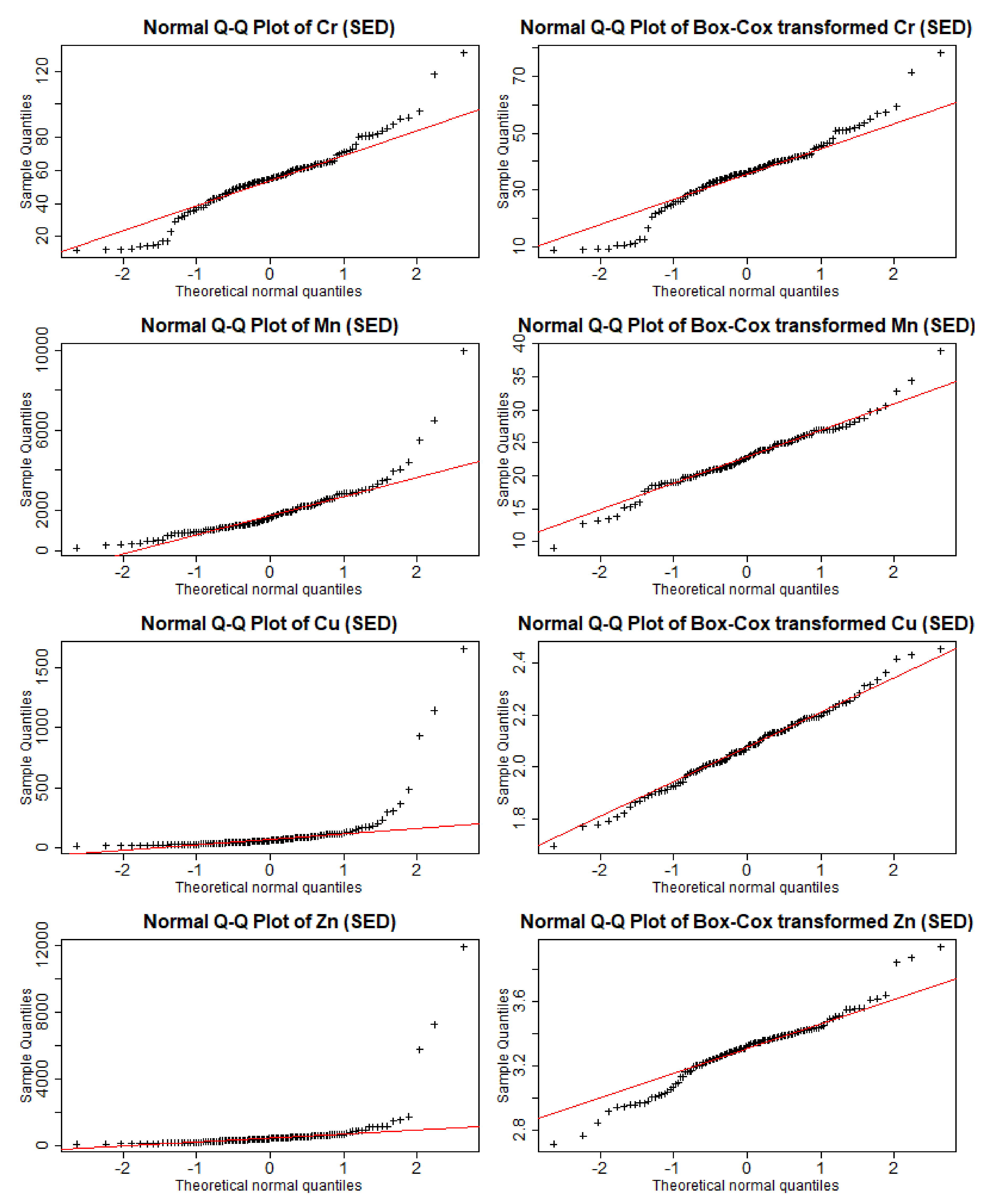
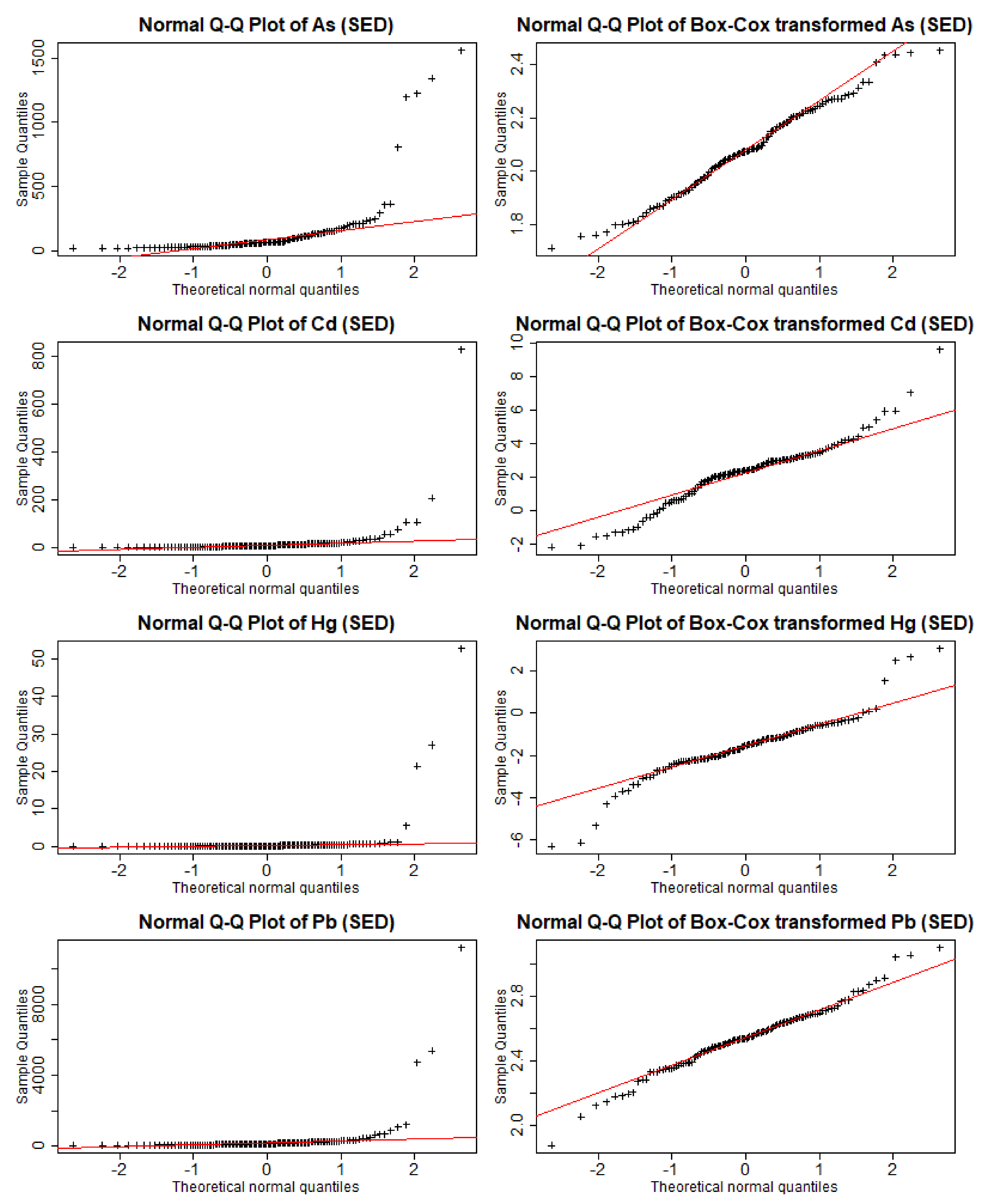
Appendix C


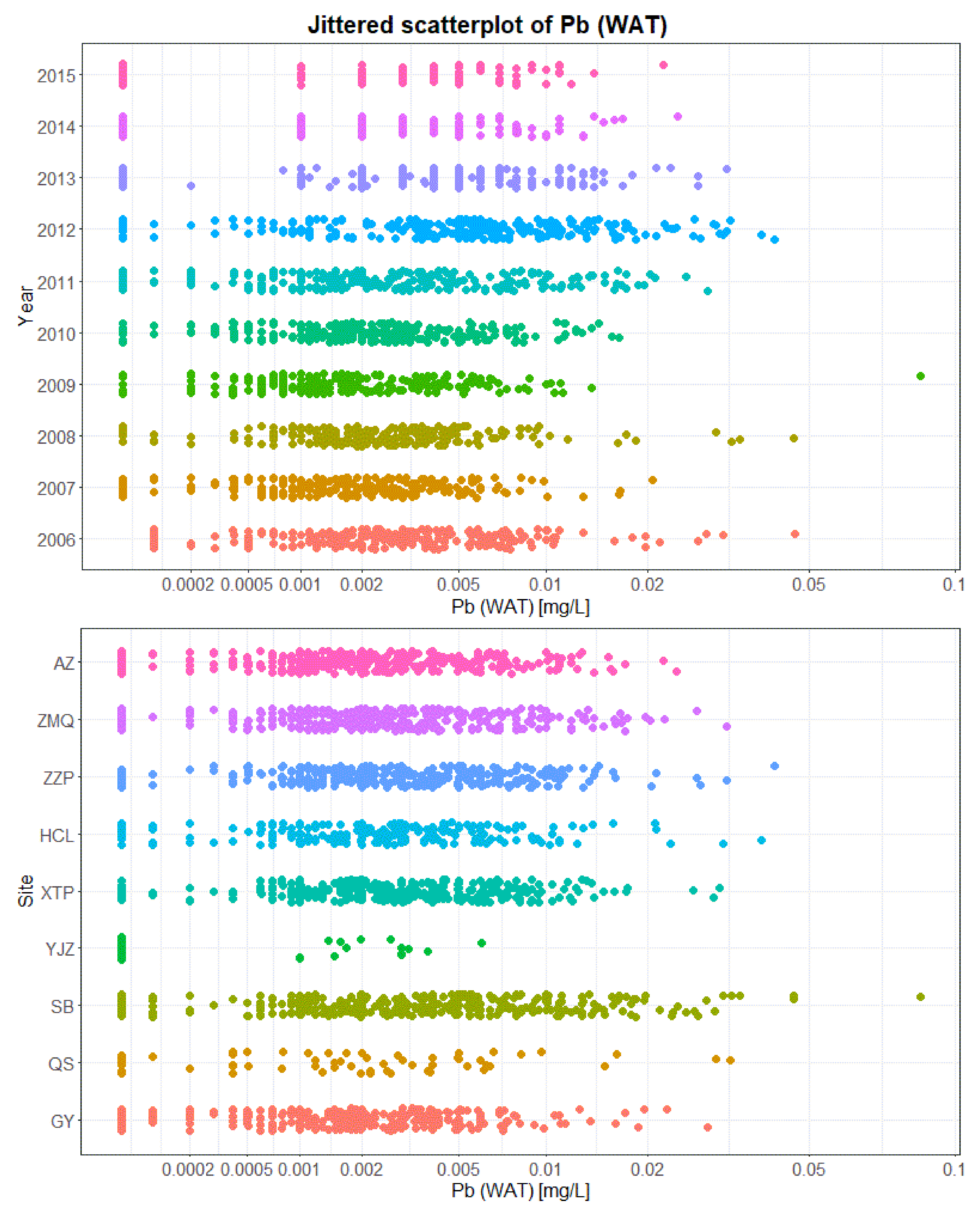

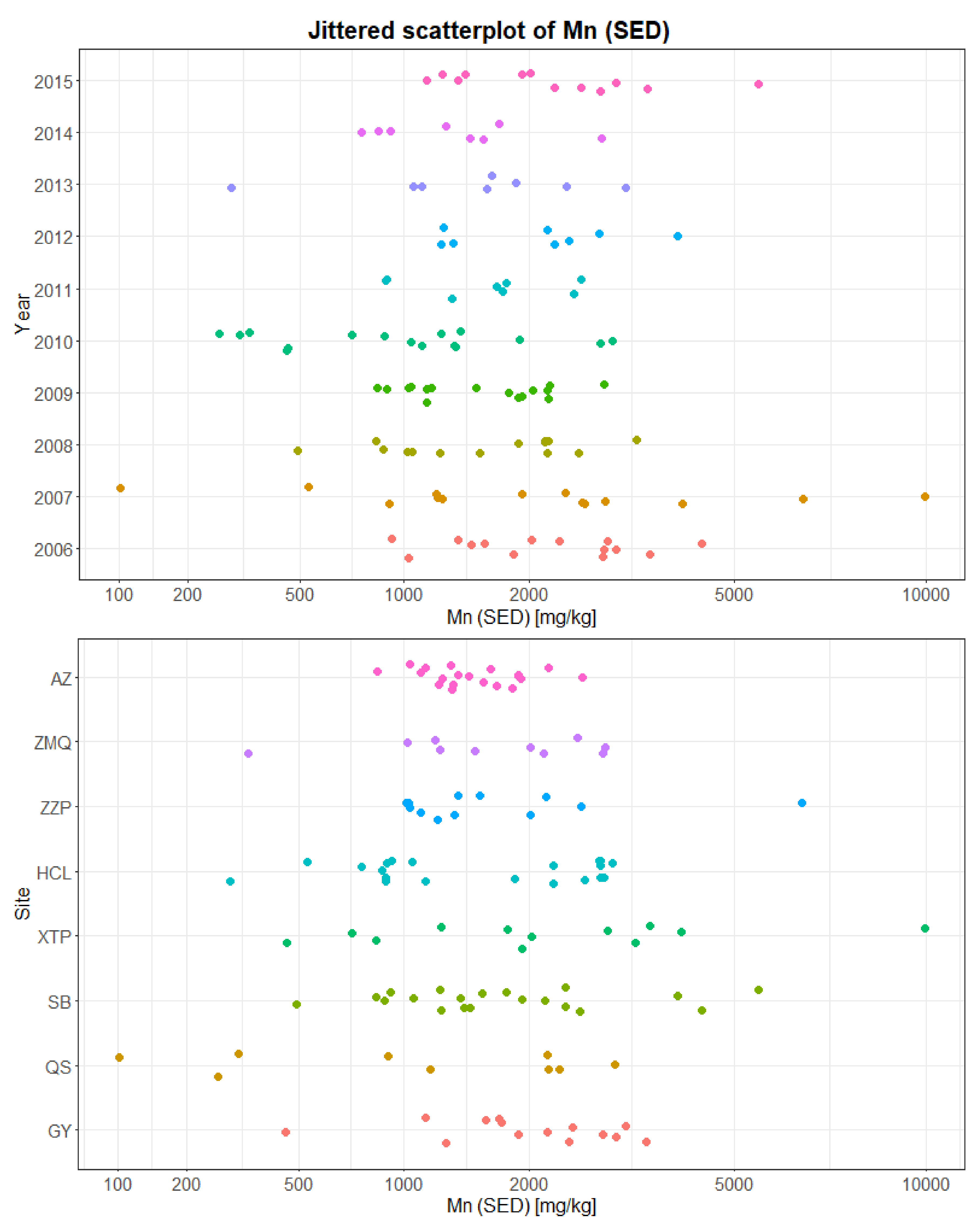


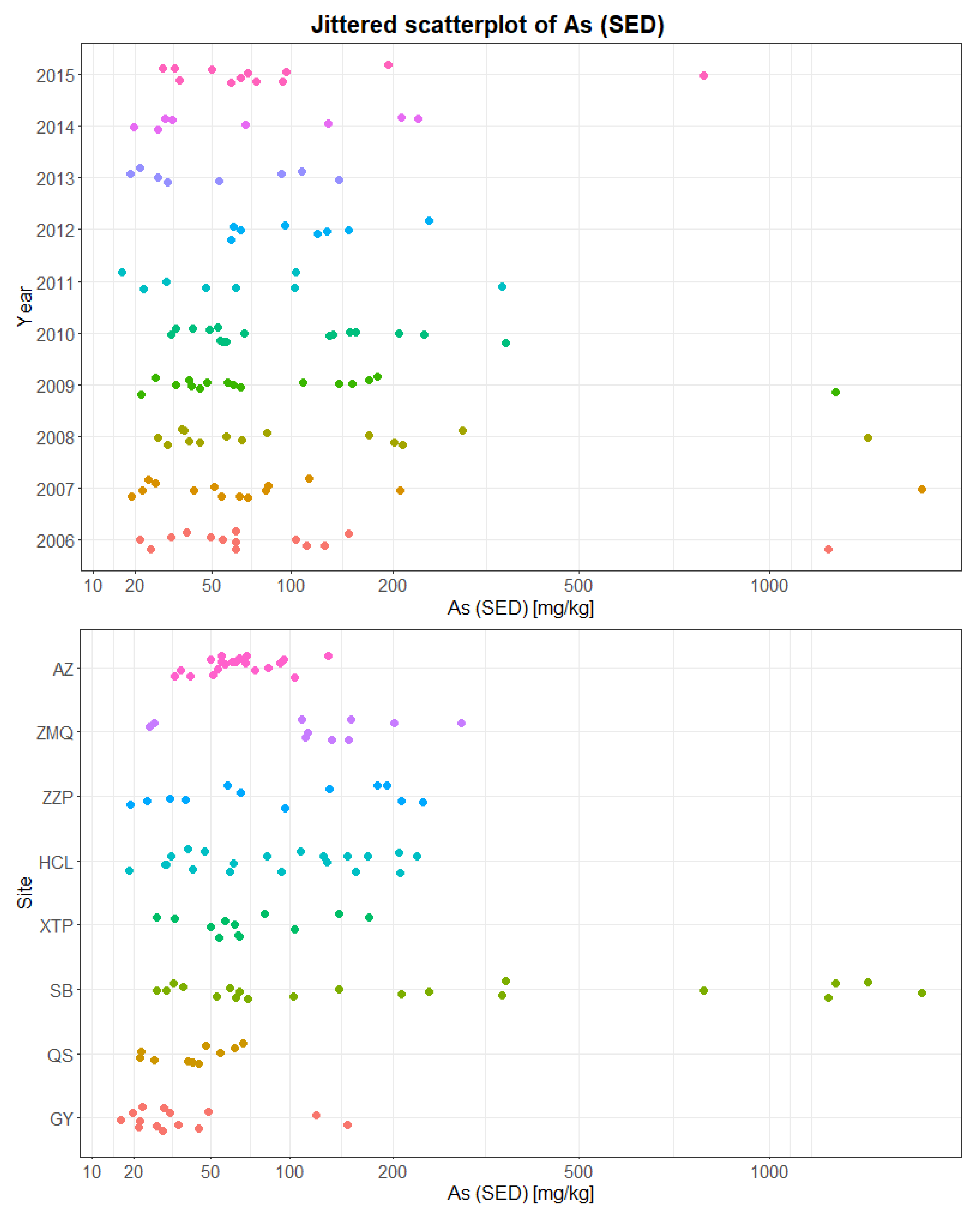


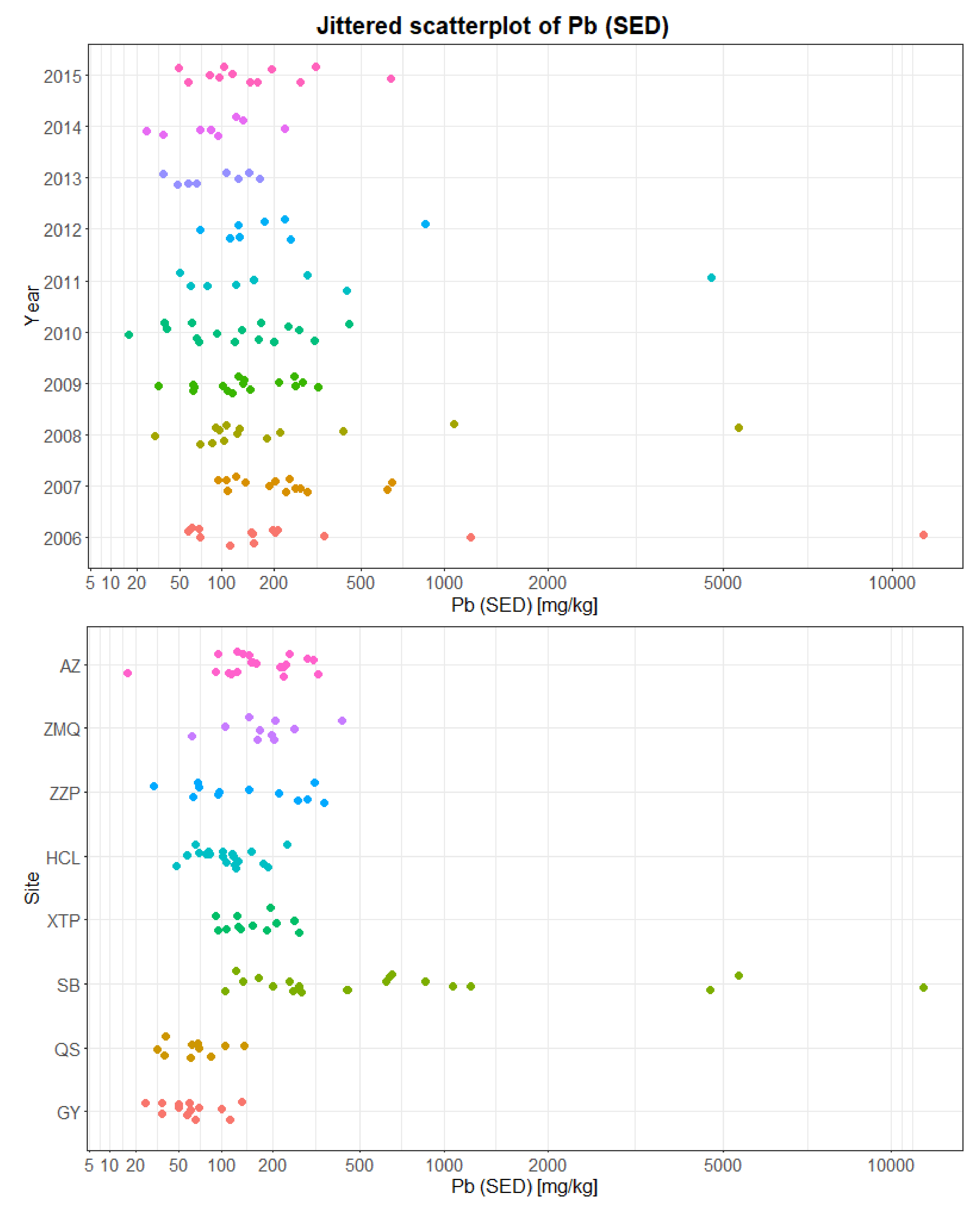
References
- Karageorgis, A.P.; Sioulas, A.; Krasakopoulou, E.; Anagnostou, C.L.; Hatiris, G.A.; Kyriakidou, H.; Vasilopoulos, K. Geochemistry of surface sediments and heavy metal contamination assessment: Messolonghi lagoon complex, Greece. Environ. Earth Sci. 2012, 65, 1619–1629. [Google Scholar] [CrossRef]
- Hudson-Edwards, K.A. Sources, mineralogy, chemistry and fate of heavy metal-bearing particles in mining-affected river systems. Mineral. Mag. 2003, 67, 205–217. [Google Scholar] [CrossRef]
- Li, F.; Zhang, J.; Jiang, W.; Liu, C.; Zhang, Z.; Zhang, C.; Zeng, G. Spatial health risk assessment and hierarchical risk management for mercury in soils from a typical contaminated site, China. Environ. Geochem. Health 2017, 39, 923–934. [Google Scholar] [CrossRef] [PubMed]
- Yang, Z.; Wu, Z.; Liao, Y.; Liao, Q.; Yang, W.; Chai, L. Combination of microbial oxidation and biogenic schwertmannite immobilization: A potential remediation for highly arsenic-contaminated soil. Chemosphere 2017, 181, 1–8. [Google Scholar] [CrossRef] [PubMed]
- Hu, H.; Jin, Q.; Kavan, P. A study of heavy metal pollution in China: Current status, pollution-control policies and countermeasures. Sustainability 2014, 6, 5820–5838. [Google Scholar] [CrossRef]
- Zitko, V. Principal component analysis in the evaluation of environmental data. Mar. Pollut. Bull. 1994, 28, 718–722. [Google Scholar] [CrossRef]
- Loska, K.; Wiechuła, D. Application of principal component analysis for the estimation of source of heavy metal contamination in surface sediments from the Rybnik Reservoir. Chemosphere 2003, 51, 723–733. [Google Scholar] [CrossRef]
- Simeonov, V.; Massart, D.; Andreev, G.; Tsakovski, S. Assessment of metal pollution based on multivariate statistical modeling of “hot spot” sediments from the Black Sea. Chemosphere 2000, 41, 1411–1417. [Google Scholar] [CrossRef]
- Tam, N.F.Y.; Wong, Y.-S. Spatial variation of heavy metals in surface sediments of Hong Kong mangrove swamps. Environ. Pollut. 2000, 110, 195–205. [Google Scholar] [CrossRef]
- Mao, L.; Mo, D.; Guo, Y.; Fu, Q.; Yang, J.; Jia, Y. Multivariate analysis of heavy metals in surface sediments from lower reaches of the Xiangjiang River, southern China. Environ. Earth Sci. 2012, 69, 765–771. [Google Scholar] [CrossRef]
- Nguyen Van, T.; Ozaki, A.; Nguyen Tho, H.; Nguyen Duc, A.; Thi, Y.T.; Kurosawa, K. Arsenic and heavy metal contamination in soils under different land use in an estuary in northern Vietnam. Int. J. Environ. Res. Public Health 2016, 13, 1091. [Google Scholar] [CrossRef] [PubMed]
- Reimann, C.; Filzmoser, P.; Garrett, R.; Dutter, R. Statistical Data Analysis Explained: Applied Environmental Statistics with R; John Wiley & Sons: Hoboken, NJ, USA, 2011. [Google Scholar]
- Hengyang Prefecture, Hunan Province, China. Available online: https://www.mindat.org/loc-713.html (accessed on 29 March 2018).
- Joanes, D.N.; Gill, C.A. Comparing measures of sample skewness and kurtosis. J. R. Stat. Soc. Ser. D Stat. 1998, 47, 183–189. [Google Scholar] [CrossRef]
- Box, G.E.; Cox, D.R. An Analysis of Transformations. J. R. Stat. Soc. Ser. B 1964, 26, 211–252. [Google Scholar]
- Cox, D.R.; Snell, E.J. Analysis of Binary Data; CRC Press: Boca Raton, FL, USA, 1989; Volume 32. [Google Scholar]
- Shapiro, S.S.; Wilk, M.B. An analysis of variance test for normality (complete samples). Biometrika 1965, 52, 591–611. [Google Scholar] [CrossRef]
- R Core Team. R: A Language and Environment for Statistical Computing; the R Foundation for Statistical Computing: Vienna, Austria, 2017. [Google Scholar]
- Filzmoser, P. StatDA: Statistical Analysis for Environmental Data, R package version 1.6.9; 2015. Available online: https://CRAN.R-project.org/package=StatDA (accessed on 29 March 2018).
- Venables, W.N.; Ripley, B.D. Modern Applied Statistics with S, 4th ed.; Springer: New York, NY, USA, 2002. [Google Scholar]
- Wickham, H. ggplot2: Elegant Graphics for Data Analysis; Springer: New York, NY, USA, 2009; ISBN 978-0-387-98140-6. [Google Scholar]
- Chai, L.; Li, H.; Yang, Z.; Min, X.; Liao, Q.; Liu, Y.; Men, S.; Yan, Y.; Xu, J. Heavy metals and metalloids in the surface sediments of the Xiangjiang River, Hunan, China: Distribution, contamination, and ecological risk assessment. Environ. Sci. Pollut. Res. 2017, 24, 874–885. [Google Scholar] [CrossRef] [PubMed]
- Vistelius, A.B. The skew frequency distributions and the fundamental law of the geochemical processes. J. Geol. 1960, 68, 1–22. [Google Scholar] [CrossRef]
- Infographic: No.1 Key Project Road Map. Available online: http://www.enghunan.gov.cn/SP/zmxj/ (accessed on 23 March 2018).
- Jin, S.; Zhou, J.; Yang, F. Government Actions in China’s Green Development. In China Green Development Index Report 2011; Springer: Berlin/Heidelberg, Germany, 2012; pp. 291–316. ISBN 978-3-642-31596-1. [Google Scholar]
- National “12th Five-Year Plan” for Environmental Protection. Available online: http://english.mep.gov.cn/Resources/Plans/National_Fiveyear_Plan/201606/P020160601356854927248.pdf (accessed on 23 March 2018).





| Variable | MIN | MEDIAN | MEAN | MAX | MAD | SD | IQR | CV% | CVR% | G1 | G1* |
|---|---|---|---|---|---|---|---|---|---|---|---|
| As (WAT) | 0.000035 | 0.00876 | 0.01358 | 0.52 | 0.007798 | 0.01881 | 0.009859 | 138.53 | 89.02 | 11.12 | 5.76 |
| Cd (WAT) | 0.00005 | 0.0013 | 0.001674 | 0.0191 | 0.001038 | 0.001532 | 0.001186 | 91.51 | 79.83 | 2.96 | 2.59 |
| Pb (WAT) | 0.00005 | 0.0020 | 0.003617 | 0.0854 | 0.00252 | 0.004957 | 0.002817 | 137.06 | 126.02 | 4.52 | 3.30 |
| Cr (SED) | 11.7 | 54.80 | 54.59 | 131 | 14.35 | 20.54 | 15.02 | 37.63 | 26.19 | 0.31 | −0.06 |
| Mn (SED) | 101 | 1620 | 1884 | 9950 | 873.3 | 1275 | 954.4 | 67.68 | 53.90 | 2.83 | 1.39 |
| Cu (SED) | 15.4 | 62.85 | 112.1 | 1650 | 39.88 | 201.4 | 45.39 | 179.69 | 63.46 | 5.67 | 5.38 |
| Zn (SED) | 63.0 | 418.5 | 659.7 | 11,900 | 229.8 | 1343 | 235.6 | 203.58 | 54.91 | 6.60 | 6.34 |
| As (SED) | 16.3 | 62.95 | 135.2 | 1561 | 49.15 | 246.2 | 69.97 | 182.06 | 78.07 | 4.34 | 4.58 |
| Cd (SED) | 0.086 | 8.595 | 21.66 | 829 | 8.903 | 78.90 | 8.766 | 364.29 | 103.58 | 9.45 | 5.17 |
| Hg (SED) | 0.011 | 0.2505 | 1.192 | 52.63 | 0.1683 | 5.726 | 0.2174 | 480.27 | 67.18 | 7.48 | 7.41 |
| Pb (SED) | 16.1 | 128.5 | 359.4 | 11,200 | 94.44 | 1203 | 107.7 | 334.61 | 73.50 | 7.41 | 6.76 |
| Variable | Raw | Box-Cox |
|---|---|---|
| As(WAT) | 4.11 × 10−65 *** | 4.34 × 10−24 *** |
| Cd(WAT) | 6.04 × 10−50 *** | 2.38 × 10−13 *** |
| Pb(WAT) | 1.13 × 10−58 *** | 1.12 × 10−25 *** |
| Cr(SED) | 7.66 × 10−4 *** | 9.42 × 10−4 *** |
| Mn(SED) | 9.80 × 10−12 *** | 4.23 × 10−2 * |
| Cu(SED) | 2.91 × 10−20 *** | 9.21 × 10−1 |
| Zn(SED) | 3.48 × 10−21 *** | 5.33 × 10−3 ** |
| As(SED) | 1.68 × 10−19 *** | 3.74 × 10−1 |
| Cd(SED) | 1.56 × 10−22 *** | 2.30 × 10−4 *** |
| Hg(SED) | 7.81 × 10−23 *** | 1.71 × 10−6 *** |
| Pb(SED) | 3.15 × 10−22 *** | 1.05 × 10−1 |
| Variable | 2006–2007 | 2007–2008 | 2008–2009 | 2009–2010 | 2010–2011 | 2011–2012 | 2012–2013 | 2013–2014 | 2014–2015 |
|---|---|---|---|---|---|---|---|---|---|
| As(WAT) | 2.21 × 10−1 | 9.97 × 10−1 | 1.16 × 10−5 *** | 1.85 × 10−3 ** | 8.93 × 10−1 | 1.98 × 10−7 *** | 2.02 × 10−6 *** | 4.82 × 10−1 | 9.71 × 10−1 |
| Cd(WAT) | 6.22 × 10−10 *** | 5.97 × 10−1 | 6.42 × 10−1 | 8.68 × 10−1 | 9.64 × 10−1 | 3.54 × 10−2 * | 1.21 × 10−7 *** | 1.54 × 10−20 *** | 3.18 × 10−9 *** |
| Pb(WAT) | 4.75 × 10−8 *** | 9.99 × 10−1 | 5.74 × 10−2 | 9.11 × 10−1 | 9.97 × 10−1 | 1.00 × 100 | 6.20 × 10−7 *** | 1.11 × 10−12 *** | 2.89 × 10−1 |
© 2018 by the authors. Licensee MDPI, Basel, Switzerland. This article is an open access article distributed under the terms and conditions of the Creative Commons Attribution (CC BY) license (http://creativecommons.org/licenses/by/4.0/).
Share and Cite
Tang, J.; Chai, L.; Li, H.; Yang, Z.; Yang, W. A 10-Year Statistical Analysis of Heavy Metals in River and Sediment in Hengyang Segment, Xiangjiang River Basin, China. Sustainability 2018, 10, 1057. https://doi.org/10.3390/su10041057
Tang J, Chai L, Li H, Yang Z, Yang W. A 10-Year Statistical Analysis of Heavy Metals in River and Sediment in Hengyang Segment, Xiangjiang River Basin, China. Sustainability. 2018; 10(4):1057. https://doi.org/10.3390/su10041057
Chicago/Turabian StyleTang, Jingwen, Liyuan Chai, Huan Li, Zhihui Yang, and Weichun Yang. 2018. "A 10-Year Statistical Analysis of Heavy Metals in River and Sediment in Hengyang Segment, Xiangjiang River Basin, China" Sustainability 10, no. 4: 1057. https://doi.org/10.3390/su10041057
APA StyleTang, J., Chai, L., Li, H., Yang, Z., & Yang, W. (2018). A 10-Year Statistical Analysis of Heavy Metals in River and Sediment in Hengyang Segment, Xiangjiang River Basin, China. Sustainability, 10(4), 1057. https://doi.org/10.3390/su10041057




